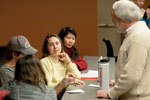
Student Project Solicitation - This newsletter issue marks the beginning of my course organization efforts for the upcoming academic year. I rely on ideas and suggestions from the local community - that's you - for identification of authentic problems that are suitable to be pursued as student projects in the course. What is the role of student projects in the course? - Students who enroll in the course have the opportunity to work in a project team with the goal of fabricating and testing a functional prototype device that addresses a specific challenge or difficulty experienced by a person with a disability or older adult in the local community. How do students benefit from the projects they work on? - These projects are a key course activity, providing students with an opportunity to exercise their knowledge and creativity to address real-world problems. In pursuing their projects, students acquire or practice (and hopefully improve) the skills that they will use thoughout their future professional careers including working in teams, interacting with people in the local community, solving problems by following an engineering design development process, employing course knowledge in a practical context, sharpening fabrication techniques, developing critical thinking skills, and enhancing presentation & report writing abilities. These are the course's primary teaching goals. In what other ways do the projects enhance a student's education? - Project involvement exposes students to the engineering, medical, and social issues facing engineers, researchers, entrepreneurs, clinicians, older adults, and individuals with disabilities and encourages them to apply their engineering skills and design expertise to help assistive technology users increase their independence and improve their quality of life. This course relies on your involvement, What are the benefits for someone who suggests a project? - Project suggestors have the opportunity to become involved in the course beyond attending lectures, including working with a team of bright Stanford students - to advance their knowledge and influence the design and development of a prototype device that addresses a specific disability or aging problem. How are projects solicited? - The process begins with an appeal to the local community to observe, identify, describe, and report challenges experienced by an individual with a disability, an older adult, or those who care for or interact with them including employers, teachers, health care professionals, and family members. What challenges would be good to target? - Acceptable challenges include difficulties in performing tasks such as working, learning, moving, communicating, accessing home products including computers, and daily living activities such as cooking, cleaning, and pursuing happiness. Project suggestions that explore design concepts that improve diagnosis, therapy, and rehabilitation are also welcomed. What is the process for considering and submitting project suggestions? - First perform an internet search to confirm that the identified problem has not already been adequately addressed. Then carefully review the project requirements to make sure the idea meets all project criteria. Finally send me a short email (text format is ok) that identifies the user or population affected and describes the nature of the problem. Include desirable features of a solution, but do not specify how the device should appear, be built, or solve the problem - as those are tasks for the student team to consider. It is ok if the problem affects just one individual. To evaluate project suggestions, refer to the current candidate project list as a guide. What happens next? - Submitted project suggestions will be read, reviewed, and considered. Those that meet all the project requirements and receive my approval will be accepted as candidate team projects. A project Problem Statement describing the project will be composed for posting on the course website and disseminated as a handout to students on the first day of class. What is the role of the individual who suggested the project during the course? - Suggestors of approved projects will have the opportunity to "pitch" it in the second class session. If a student team selects the project, the suggestor must be available to assist them with advice, direction, and expertise in person, or by phone, and/or email during the quarter and will be invited to attend the Student Team Project Final Presentations and Project Demonstrations at the end of the term. What is the deadline for submitting project suggestions? - Please email suggestions to me as soon as possible so I have adequate time to consider all submissions, edit approved entries, and post them - not later than Friday, December 1st. Upcoming Local Event
Support the course - Funding in any amount for the course and student projects is always welcomed. Monetary gifts support approved project expenses, administrative costs, honoraria for guest lecturers, and the end-of-term celebration. Refer to the Team Project Support webpage for more information. Email questions, comments, or suggestions - Please email me if you have general questions, comments, or suggestions regarding the course. Thank you again for your interest. Dave
|
||||||||||||||||||||||||||



